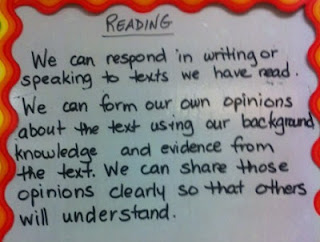Responding to and Evaluating Texts
1.8 make judgements and draw conclusions
about ideas in texts and cite stated or
implied evidence from the text to
support their views
Teacher prompts: “What conclusions
can you draw from the events or information presented in the text?” “Has
the author chosen the most convincing
facts to support his or her opinion?”
We've been looking at short informational texts. I've been using articles about Space because I believe that as much as possible, it makes sense to tie in my content areas to my Language program (it's like killing two -or three or four - birds with one stone).
Here is my "Instructional Pathway" for Reading from the last two weeks.
Day 1
I actually put our specific expectation from the Language Curriculum document up on LCD projector, read it to the students, and said, "It is difficult to make sense of this expectation, how can we put it into our own words so that it makes sense to us?". This is what my students came up with for our Learning Goal in Reading:
Then, I read aloud a passage called "Space Junk" and modeled for them how I paused to check for understanding, how I asked questions as I read, and how I made connections and inferences to better understand the text.
Day 2
The next day, I took a text from our EQAO samples called "The Constellations", (found on line; even if you are not from Ontario, there is a great selection of texts and student exemplars found here). Again, I modeled how I used the comprehension strategies to understand the text, but this time I used a document camera so that I could mark up the text and they could "see" my thinking.
Day 3
We looked at the open response questions from EQAO that went with this particular text. I made several copies of the student exemplars from each level, and in groups, my students had to order the responses, and then provide "feedback" to the students who wrote the responses, i.e. what they did well, what next steps they should take to "bump up" their work. My kids LOVED doing this! They wanted to know if they could really send their feedback to these sample students! They even decided to name their "mystery students"!
We posted the student exemplars on our "Bump it Up Wall" along with post-it notes with our feedback, as we did a couple of months ago with our Math journal samples.
Day 4
I asked the students to consider the feedback we gave our "mystery students" the previous day, and in groups, they then began to consider what they felt are the criteria for success for a good reading response. We took those up, and as a class wrote up the Success Criteria for a successful reading response.
Day 5
Between Day 3 and Day 4, we had a PLC on Learning Goals and Success Criteria. We watched a video from Anne Davies and Sandra Herbst's blog on how to have students co-create Success Criteria. In the video, the teacher said that it is important to have the students sort or categorize the criteria. I was doubtful about this step, but my Literacy Coach wanted my to try it with my students. This is what they came up with - and honestly, these criteria suddenly made more sense to me - I love it when I get to learn from my students!
Day 6
With that established, I once again had an article to share with them, this time on our favourite Canadian astronaut, Chris Hadfield, (from Teaching Kids News), using the document camera. This time, they each had a copy of the article in front of them and we did a shared reading of the article. We coded the text together, they shared their thinking, I shared mine, and we documented ALL of it on our articles.
Day 7
I posted a question from the article on Chris Hadfield. With a partner, the students wrote a response to the question using the Success Criteria as a guide. We then used the document camera to review each response and provide feedback. I find the students are quite comfortable with this for a few reasons; 1- we have created a risk-free environment where it is safe to make mistakes, 2- they were explicitly taught how to give feedback in appropriate ways, our feedback is now solely based on the criteria, 3- because they worked in partners, it is less personal.
Using all of the feedback, we share-wrote a final response together using the document camera.
I think it is very important to use the gradual release model in our teaching practice. It is slow, and explicit, but I think it pays off in the end.
So what comes next? The students will meet with me in small groups and I will give them guided support in responding to informational texts at their reading levels. They will also have opportunities to practice responding to these texts with a partner, and then on their own. I will provide them with feedback throughout, and they will also provide one another with feedback. Once we've had lots of practice and feedback, I will then do an Assessment OF Learning to see if they have in fact "bumped up" their work!





I’m impressed. Very informative and trustworthy blog does exactly what it sets out to do. I’ll bookmark your weblog for future use.
ReplyDeletePebbles
www.joeydavila.net